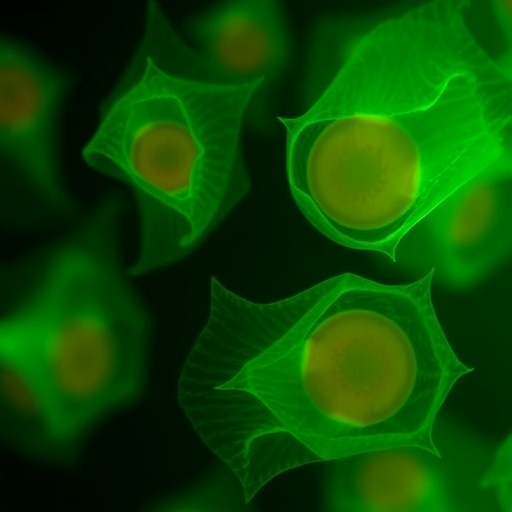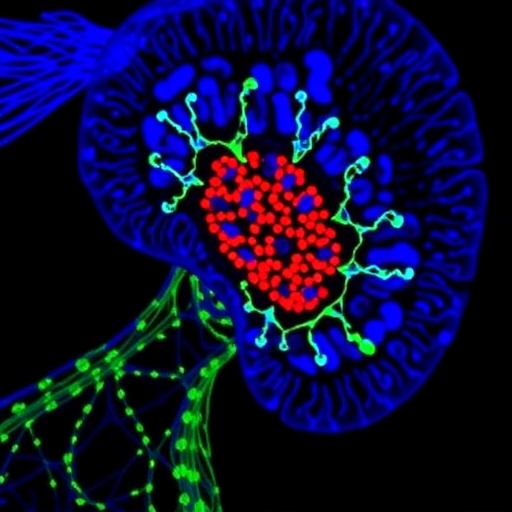PROTECT YOUR DNA WITH QUANTUM TECHNOLOGY
Orgo-Life the new way to the future Advertising by AdpathwayIn a groundbreaking new study, researchers have unveiled a complex molecular mechanism that underpins resistance to vemurafenib, a targeted therapy widely used in the treatment of melanoma. This discovery could revolutionize the way we understand drug resistance in melanoma, offering fresh hope for overcoming therapeutic barriers in this aggressive cancer. The study, conducted by Liu, Liang, Wang, and colleagues, sheds light on the role of the long non-coding RNA (lncRNA) LINC01198 as a pivotal activator of the Hippo signaling pathway, ultimately stimulating IL-1β autocrine signaling and driving vemurafenib resistance through direct interaction with TAOK1 and TAOK2 kinases.
Melanoma, notoriously known for its high mutation rate and aggressive nature, often exhibits initial responsiveness to targeted therapies like vemurafenib, a BRAF inhibitor. However, despite initial success, resistance to this drug commonly develops, leading to treatment failure and poor patient prognosis. The mechanisms behind this resistance have puzzled oncologists and researchers for years. The current study significantly advances our understanding by pinpointing the critical involvement of non-coding RNA and intracellular signaling crosstalk in fostering a resistant tumor microenvironment.
At the molecular level, the research team discovered that LINC01198, previously known to be involved in various cancer-related processes, is markedly upregulated in melanoma cells exhibiting resistance to vemurafenib. This upregulation seems to correlate strongly with poor therapeutic outcomes. The investigators employed a combination of RNA sequencing, biochemical assays, and functional studies to elucidate how LINC01198 orchestrates resistance. Their findings indicate that LINC01198 does not act in isolation but instead forms a complex with TAOK1 and TAOK2, members of the Ste20 kinase family, which play critical roles in activating the Hippo signaling pathway.
The Hippo pathway is a key regulatory axis controlling cell growth, apoptosis, and tissue homeostasis, frequently implicated in cancer development and progression. By activating this pathway through its association with TAOK1/2, LINC01198 facilitates downstream signaling events that culminate in the production and release of IL-1β, a potent pro-inflammatory cytokine. The secretion of IL-1β establishes an autocrine loop that further sustains resistance mechanisms within melanoma cells, reinforcing survival pathways that enable tumor cells to evade the cytotoxic effects of vemurafenib.
Remarkably, the study not only delineates the molecular cascade but also demonstrates that interrupting this axis can restore drug sensitivity in resistant melanoma cell lines. Silencing LINC01198 or pharmacologically inhibiting TAOK1/2 effectively dampened Hippo pathway activation and suppressed IL-1β production, leading to increased apoptosis and reduced tumor cell viability in the presence of vemurafenib. These insights suggest that targeting this lncRNA-mediated signaling network could represent a promising therapeutic strategy to overcome resistance.
Importantly, the study emphasizes the autocrine nature of IL-1β signaling, highlighting how melanoma cells become self-sufficient in promoting their survival under therapeutic stress. This autocrine stimulation creates a vicious cycle reinforcing resistance and immune evasion. IL-1β, traditionally recognized for its role in inflammation and immune responses, is shown here to have a dual function in cancer biology by directly empowering tumor cells with adaptive resistance capabilities.
The clinical implications of these findings are profound. By identifying LINC01198 as a key driver of vemurafenib resistance, clinicians may have a new biomarker to predict therapeutic outcomes and tailor treatments more effectively. Moreover, the potential to develop novel inhibitors targeting LINC01198 or its interaction with TAOK kinases opens avenues for combination therapies, which may prevent or delay the emergence of resistance in melanoma patients undergoing BRAF-targeted treatment.
The study’s multi-faceted approach, encompassing transcriptomics, protein interaction analyses, and functional validations in cell and animal models, confirms the robustness of the findings. This integrative strategy strengthens the case for considering non-coding RNAs as central modulators in oncogenic signaling pathways and therapeutic resistance, an area that is rapidly emerging as a frontier in cancer research.
Given the high mortality associated with advanced melanoma and the limited options once targeted therapies fail, this research addresses a critical unmet need. The ability to modulate the Hippo signaling pathway through its upstream regulators like TAOK1/2, controlled by lncRNA LINC01198, may not only improve responses to existing drugs but also inspire new drug development efforts aimed at these previously underappreciated molecular targets.
In addition to its therapeutic implications, the study enriches our understanding of cancer biology by illustrating the dynamic interplay between non-coding RNAs, kinase signaling, and inflammatory cytokine networks. Such complexity underscores the necessity for multifactorial treatment approaches that consider the tumor microenvironment and intrinsic cellular adaptation mechanisms.
Future research stemming from these findings may explore the broader applicability of LINC01198-Hippo-IL-1β signaling axis in other cancers that exhibit similar resistance phenotypes. This could potentially redefine treatment paradigms beyond melanoma, benefiting a wider spectrum of cancer patients facing drug resistance challenges.
The authors also suggest investigating whether co-targeting immune checkpoints alongside modulating this signaling axis could yield synergistic responses, given the involvement of IL-1β in immune modulation. Such combination therapies could harness the immune system while neutralizing tumor survival signals, offering a multipronged attack on resistant tumors.
Moreover, understanding the regulation of LINC01198 expression itself remains an open question; uncovering upstream factors or environmental cues that trigger its upregulation may provide additional layers for therapeutic intervention. This could involve epigenetic modifications, transcription factor activity, or microenvironmental stressors induced by drug treatment.
Overall, this seminal study represents a significant leap forward in decoding the molecular underpinnings of melanoma resistance to vemurafenib. By spotlighting LINC01198 as a master regulator of Hippo signaling and IL-1β autocrine stimulation through TAOK1/2 engagement, it paves the way for innovative strategies aimed at circumventing resistance and enhancing patient survival in the clinic.
As melanoma continues to pose formidable challenges, discoveries such as these fuel optimism that integrating molecular insights with clinical practice will ultimately transform treatment landscapes. The intersection of non-coding RNA biology, intracellular signaling, and inflammatory pathways opens novel therapeutic windows, promising more durable and effective cancer therapies.
This rapidly evolving field exemplifies the power of modern molecular oncology research in identifying previously unrecognized drivers of resistance and leveraging that knowledge for impactful clinical advancements. The study by Liu and colleagues provides a compelling blueprint for how targeting lncRNAs and their associated signaling complexes can redefine the fight against refractory cancers.
Subject of Research:
Molecular mechanisms of vemurafenib resistance in melanoma involving lncRNA LINC01198, Hippo signaling pathway, and IL-1β autocrine stimulation.
Article Title:
LINC01198 activates Hippo signaling to stimulate IL-1β autocrine for driving vemurafenib resistance by associating with TAOK1/2 in melanoma.
Article References:
Liu, J., Liang, X., Wang, K. et al. LINC01198 activates Hippo signaling to stimulate IL-1β autocrine for driving vemurafenib resistance by associating with TAOK1/2 in melanoma. Cell Death Discov. 11, 486 (2025). https://doi.org/10.1038/s41420-025-02773-6
Image Credits: AI Generated
DOI: https://doi.org/10.1038/s41420-025-02773-6
Tags: cancer-related non-coding RNA roleshigh mutation rate in melanomaHippo pathway activation in melanomaIL-1β autocrine signalingLINC01198 vemurafenib resistancelong non-coding RNA in cancermelanoma treatment failuremolecular mechanisms of drug resistanceovercoming therapeutic barriers in cancersignaling crosstalk in tumor microenvironmentTAOK1 TAOK2 kinases interactiontargeted therapy challenges in melanoma


 4 hours ago
11
4 hours ago
11





















 English (US) ·
English (US) ·  French (CA) ·
French (CA) ·